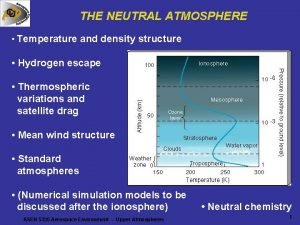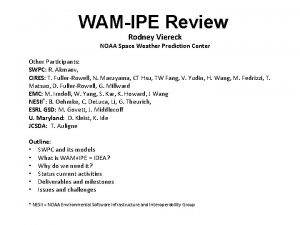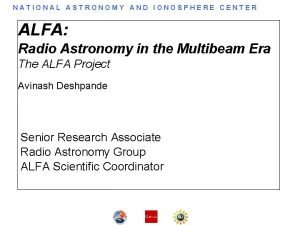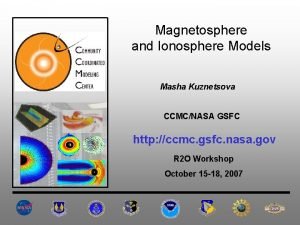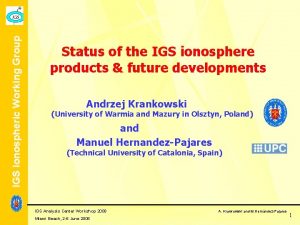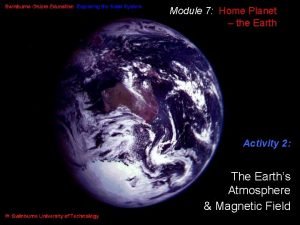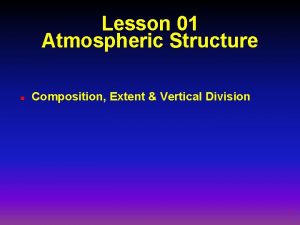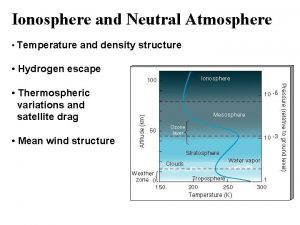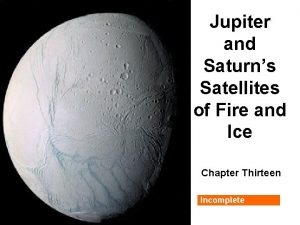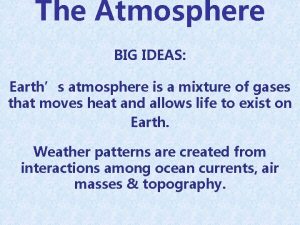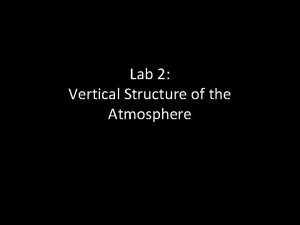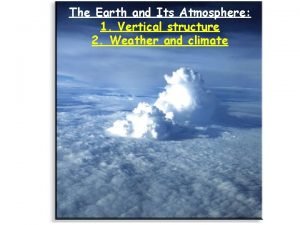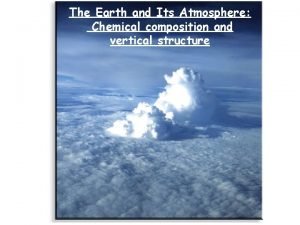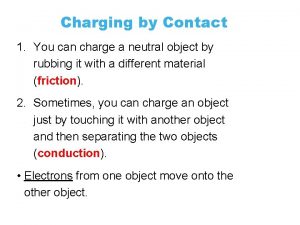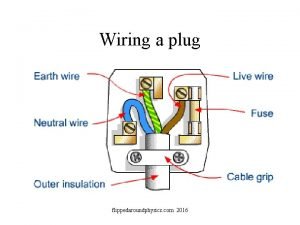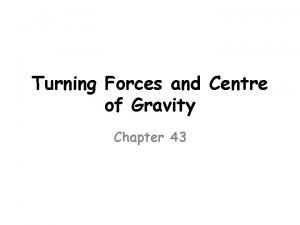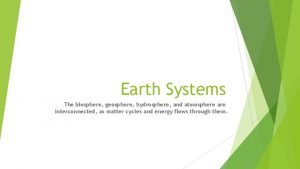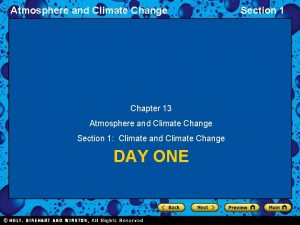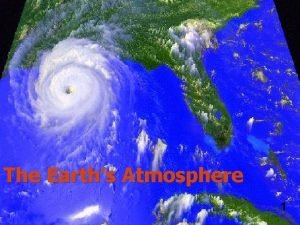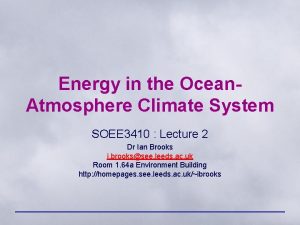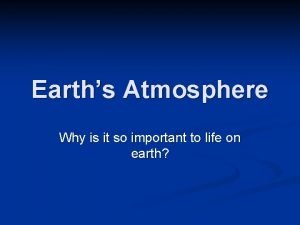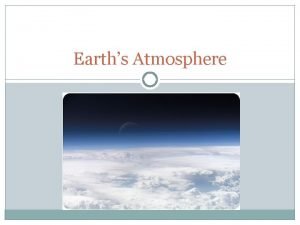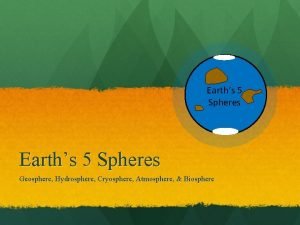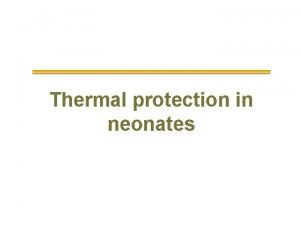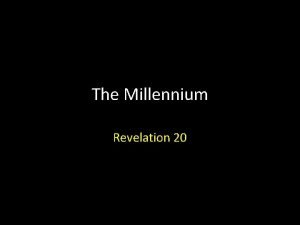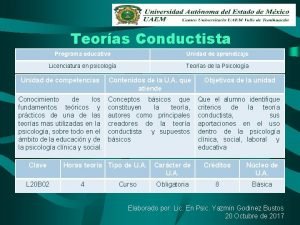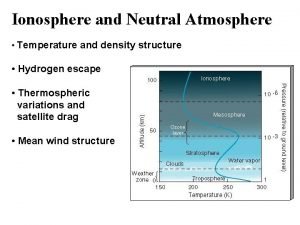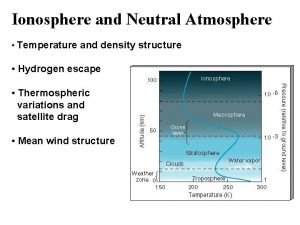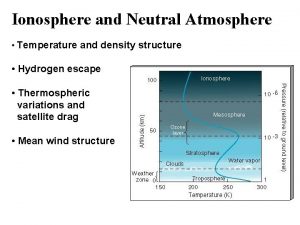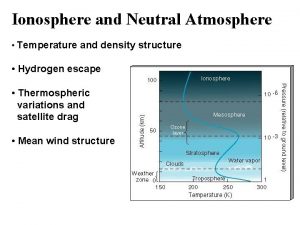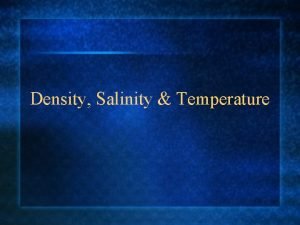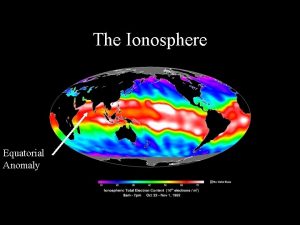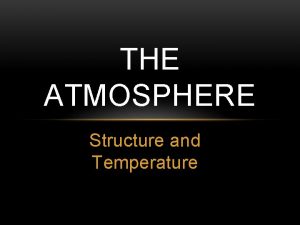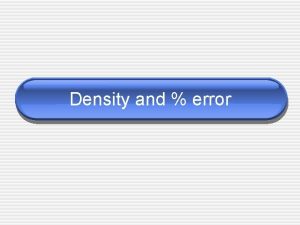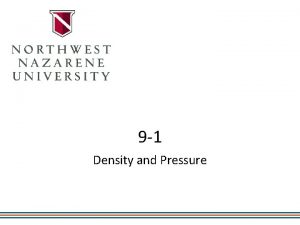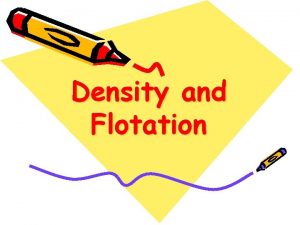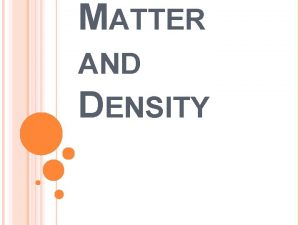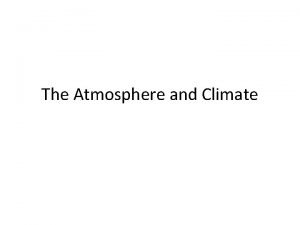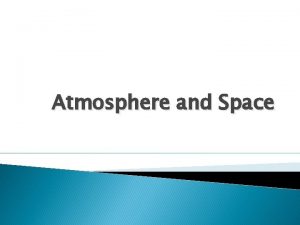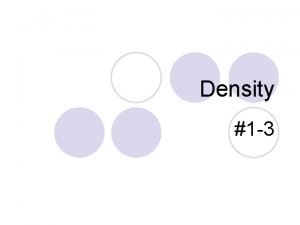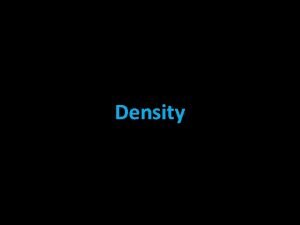Ionosphere and Neutral Atmosphere Temperature and density structure


























































- Slides: 58

Ionosphere and Neutral Atmosphere • Temperature and density structure • Hydrogen escape • Thermospheric variations and satellite drag • Mean wind structure

Tropo (Greek: tropos); “change” Lots of weather Strato (Latin: stratum); Layered Meso (Greek: messos); Middle Thermo (Greek: thermes); Heat Exo (greek: exo); outside

Variation of the density in an atmosphere with constant temperature (750 K).

Photon energy E=h Wavelength =c/ Ionization energy of ~4 e. V corresponds to wavelength of ~300 nm h=6. 623 x 10 -34 Js e. V=1. 602 x 10 -19 J c=2. 998 x 108 m/s 4

• The radiation from the Sun at short wave lengths causes photo ionization of the atmosphere resulting in a partially ionized region called the ionosphere. • Guglielmo Marconi’s demonstration of long distance radio communication in 1901 started studies of the ionosphere. • Arthur Kennelly and Oliver Heaviside independently in 1902 postulated an ionized atmosphere to account for radio transmissions. (Kennelly-Heavyside layer is now called the E-layer). • Larmor (1924) developed a theory of reflection of radio waves from an ionized region. • Breit and Tuve in 1926 developed a method for probing the ionosphere by measuring the round-trip for reflected radio waves.


• The ionosphere vertical density pattern shows a strong diurnal variation and a solar cycle variation. • Identification of ionospheric layers is related to inflection points in the vertical density profile. Region Primary Ionospheric Regions Altitude Peak Density D 60 -90 km E 90 -140 km F 1 140 -200 km F 2 200 -500 km Topside above F 2 90 km 108 – 1010 m-3 110 km Several x 1011 m-3 200 km Several 1011 -1012 m-3 12 -3 300 km Several x 10 m

• Diurnal and solar cycle variation in the ionospheric density profile. – In general densities are larger during solar maximum than during solar minimum. – The D and F 1 regions disappear at night. – The E and F 2 regions become much weaker. – The topside ionosphere is basically an extension of the magnetosphere.

• Composition of the dayside ionosphere under solar minimum conditions. – At low altitudes the major ions are O 2+ and NO+ – Near the F 2 peak it changes to O+ – The topside ionosphere becomes H+ dominant. • • • For practical purposes the ionosphere can be thought of as quasi-neutral (the net charge is practically zero in each volume element with enough particles). The ionosphere is formed by ionization of the three main atmospheric constituents N 2, O 2, and O. The primary ionization mechanism is photoionization by extreme ultraviolet (EUV) and X-ray radiation. – In some areas ionization by particle precipitation is also important. • The ionization process is followed by a series of chemical reactions – Recombination removes free charges and transforms the ions to neutral particles.

• Neutral density exceeds the ion density below about 500 km.

• Let the photon flux per unit frequency be – The change in the flux due to absorption by the neutral gas in a distance ds is where n(z) is the neutral gas concentration, is the frequency dependent photo absorption cross section, and ds is the path length element in the direction of the optical radiation. (Assuming there are no local sources or sinks of ionizing radiation. ) – (where is the zenith angle of the incoming solar radiation. – The altitude dependence of the solar radiation flux becomes where is the incident photon intensity per unit frequency. – is called the optical depth. – There is usually more than one atmospheric constituent attenuating the photons each of which has its own cross section.

• • • The density (ns) of the neutral upper atmosphere usually obeys a hydrostatic equation where m is the molecular or atomic mass, g is the acceleration due to gravity, z is the altitude and p=nk. T is thermal pressure. If the temperature T is assumed independent of z, this equation has the exponential solution where is the scale height of the gas, and n 0 is the density at the reference altitude z 0. For this case • For multiple species • The optical depth increases exponentially with decreasing altitude. In thermosphere solar radiation is absorbed mainly via ionization processes. Let us assume that Each absorbed photon creates a new electron-ion pair therefore the electron production is • • where Si is the total electron production rate (particles cm-3 s-1).

• • Substituting for n and gives where • This is the Chapman ionization function. • The maximum rate of ionization is given by • If we further assume that the main loss process is ion-electron recombination with a coefficient The altitude of maximum ionization can be obtained by looking for extremes in this equation by calculating • This gives • Choose z 0 as the altitude of maximum ionization for perpendicular solar radiation • This gives and assume that the recombination rate is • Finally if we assume local equilibrium between production and loss we get

• The vertical profile in a simple Chapman layer is • The E and F 1 regions are essentially Chapman layers while additional production, transport and loss processes are necessary to understand the D and F 2 regions.

At 80 -100 km, the time constant for mixing is more efficient than recombination, so mixing due to turbulence and other dynamical processes must be taken into account (i. e. , photochemical equilibrium does not hold). Mixing transports O down to lower (denser) levels where recombination proceeds rapidly (the "sink" for O). O Concentration After the O recombines to produce O 2, the O 2 is transported upward by turbulent diffusion to be photodissociated once again (the "source" for O).

• The D Region – The most complex and least understood layer in the ionosphere. – The primary source of ionization in the D region is ionization by solar X-rays and Lymanionization of the NO molecule. – Precipitating magnetospheric electrons may also be important. – The primary positive ions are O 2+ and NO+ – The most common negative ion is NO 3 • The E Region – Essentially a Chapman layer formed by EUV ionization. – The main ions are O 2+ and NO+ – Although nitrogen (N 2) molecules are the most common in the atmosphere N 2+ is not common because it is unstable to charge exchange. For example – Oxygen ions are removed by the following reactions

• The F 1 Region – Essentially a Chapman layer. – The ionizing radiation is EUV at <91 nm. – It is basically absorbed in this region and does not penetrate into the E region. – The principal initial ion is O+. – O+ recombines in a two step process. • First atom ion interchange takes place • This is followed by dissociative recombination of O 2+ and NO+

• The F 2 Region – The major ion is O+. – This region cannot be a Chapman layer since the atmosphere above the F 1 region optically thin to most ionizing radiation. – This region is formed by an interplay between ion sources, sinks and ambipolar diffusion. – The dominant ionization source is photoionization of atomic oxygen – The oxygen ions are lost by a two step process • First atom-ion interchange • Dissociative recombination – The peak forms because the loss rate falls off more rapidly than the production rate. – The density falls off at higher altitudes because of diffusion- no longer in local photochemical equilibrium.

Radio Sounding • What is radio sounding – Remote sensing with radio waves • Earth space physics applications – Ionosphere – Magnetosphere 19

Ionosonde Field of View and ISR Radar Pencil Beam Specular Reflection and Scatter Radio Sounding: specular reflection wide beam Scatter Radar: Scatter, pencil beam Ionosonde

Radio Sounding Principles • Waves in a plasma experience reflection and refraction • Radio waves are reflected at wave cutoffs (n = 0) • Echoes are received if the gradient at the reflection point is normal to the incident signals. • The echo frequency gives the plasma conditions of the reflection point, and the time delay gives the distance of reflection point. • From a seriesn>0 of sounding frequencies, a density profile can be Refracted rays n=0 obtained n<0 SOUNDER Echo Reflected ray Refracted rays

Principles of Radio Sounding • Radio waves are reflected at wave cutoffs (n = 0) • In a cold, magnetized plasma the cutoff frequencies are – Ionic or ordinary (O-mode): Wave frequency = fp – Extraordinary (X-mode): Wave frequency = • Echo from reflections perpendicular to density contours (at reflection point) n>0 n=0 Refracted rays n<0 Echo Use crossed-dipole antennas to identify O and X waves Refracted rays 22

Sounding Tools VA RR AY RCV ANTENNA DPS 4 RC XMT ANTENNA ionospheric ground-based sounding 23

Ionogram and Plasma Density Inversion Electron density profile 24

Ne(h, t) at the Magnetic Equator Cachimbo 16 October 2002 noon midnight 25

Ionospheric Drift Measurements • Fourier analysis for Doppler spectra • Interferometry with spaced receive antennas

Interferometric Doppler Imaging The digisonde, operating in the skymap/drift mode, is designed to measure the drift velocity components on a routine basis. In this mode the ionosonde sounds at one or more fixed frequencies and receives and records the reflected signal from each antenna separately. This technique depends on the presence of ionospheric structures that are embedded in the background plasma. 27

Digisonde Skymaps: Reflections and Doppler Shifts 28

Real Time Digisonde F-Region Drift Measurements 29

IMAGE Spacecraft 20 -m dipole along z 500 -m dipoles in spin plane Launched 25 Mar 2000 RPI: <10 W radiated power 3 k. Hz – 3 MHz 300 Hz bandwidth 30

RPI IMAGE Instrument Deck 31

RPI on IMAGE Electronics Unit 32

33 Sounding in Magnetosphere

Field-Aligned Propagation RPI Plasmagram Fig 2 of GRL paper 34 (Reinisch et al. , GRL, 2002)

Plasma Density Along Field line 35

One Pass of IMAGE on June 8, 2001 IMAGE trajectory 36

Two dimensional density distribution for MLT=8. 0 on June 8, 2001 37

Plasmasphere Depleting and Refilling Storm DST full depleted Lppstorm full 38

Before Storm Partial Recovery Storm Peak • Identified plasmasphere, plasma trough, density depletion, aurora/cusp, and polar cap • The densities and the locations of these regions vary in accordance with the different solar wind/IMF conditions, not correlated with the Dst variations 39

Before Storm Partial Recovery Storm Peak • Acceleration regions 40

Ionospheric Topside Sounding TOPAS TOPside Automated Sounder Ionosphere Disturbance Tx TOPAS Vertical Echo Disturbance 41

TOPAS : Topside Plasma Radar 42

Dual-Frequency Precision Ranging Swarm spacecraft configuration for precision interferometry -- 0. 1 W transmissions from each s/c -- Each s/c transmits own frequency -- Each s/c receives all frequencies Swarm performs as a multi-antenna interferometer for precision angle-of-arrival measurements --High resolution interferometry for detection of radio transmitters 43

Magnetospheric Tomography • A 7 -satellite constellation • Each satellite transmits and receives signals • Tomography methods are used to infer the plasma density distribution within the constellation 44

Digisonde Network

• The dense regions of the ionosphere (the D, E and F regions) contain concentrations of free electrons and ions. These mobile charges make the ionosphere highly conducting. • Electrical currents can be generated in the ionosphere. • The ionosphere is collisional. Assume that it has an electric field but for now no magnetic field. The ion and electron equations of motion will be where is the ion neutral collision frequency and neutral collision frequency. is the electron – For this simple case the current will be related to electric field by where is a scalar conductivity. • If there is a magnetic field there are magnetic field terms in the momentum equation. In a coordinate system with along the z-axis the conductivity becomes a tensor.

• Specific conductivity – along the magnetic field • Pedersen conductivity – in the direction of the applied electric field • Hall conductivity – in the direction perpendicular to the applied field where and are the total electron and ion momentum transfer collision frequencies and are the electron and ion gyrofrequencies. • The Hall conductivity is important only in the D and E regions. • The specific conductivity is very important for magnetosphere and ionosphere physics. If all field lines would be equipotentials. • The total current density in the ionosphere is

• Within the high latitude magnetosphere (auroral zone and polar cap) plasmas undergo a circulation cycle. – At the highest latitudes the geomagnetic field lines are “open” in that only one end is connected to the Earth. – Ionospheric plasma expands freely in the flux tube as if the outer boundary condition was zero pressure. • For H+ and He+ plasma enters the flux tube at a rate limited by the source. • The net result is a flux of low density supersonic cold light ions into the lobes. • The surprising part is that comparable O+ fluxes also are observed.

Vertical distribution of density and temperature for high solar activity (F 10. 7 = 250) at noon (1) and midnight (2), and for low solar activity (F 10. 7 = 75) at noon (3) and midnight (4) according to the COSPAR International Reference Atmosphere (CIRA) 1965.

Atmospheric Compositions Compared The atmospheres of Earth, Venus and Mars contain many of the same gases, but in very different absolute and relative abundances. Some values are lower limits only, reflecting the past escape of gas to space and other factors.

Average Temperature Profiles for Earth, Mars & Venus Mars Venus night day Venus Earth

Formation of Ionospheres

HYDROSTATIC EQUILIBRIUM If …. . n = # molecules per unit volume P + d. P m = mass of each particle nm dh = total mass contained in a cylinder of air (of unit cross-sectional area) Then, the force due to gravity on the cylindrical mass = g nmdh and the difference in pressure between the lower and upper faces of the cylinder balances the above force in an equilibrium situation: d. P nmgdh P

Assuming the ideal gas law holds, Then the previous expression may be written: where H is called the scale height and

This is the so-called hydrostatic law or barometric law. Integrating, where and z is referred to as the "reduced height" and the subscript zero refers to a reference height at h=0. Similarly, For an isothermal atmosphere, then,



Absorption of Solar Radiation vs. Height and Species
 Neutral atmosphere
Neutral atmosphere Wam-ipe
Wam-ipe Ionosphere
Ionosphere Astronomy
Astronomy Jdiss
Jdiss Ionosphere
Ionosphere Ionosphere
Ionosphere Ionosphere
Ionosphere Vertical division of atmosphere
Vertical division of atmosphere Ionosphere
Ionosphere Europa atmosphere density
Europa atmosphere density Specific gravity units
Specific gravity units Hcp linear density
Hcp linear density Linear density of fcc 110
Linear density of fcc 110 Difference between curie temperature and neel temperature
Difference between curie temperature and neel temperature Difference between curie temperature and neel temperature
Difference between curie temperature and neel temperature Ferromagnetis
Ferromagnetis What does arithmetic density tell us
What does arithmetic density tell us High density low density
High density low density Physiologic population density
Physiologic population density Explain composition and structure of atmosphere
Explain composition and structure of atmosphere Lab 1 vertical structure of the atmosphere
Lab 1 vertical structure of the atmosphere Vertical structure of the earth
Vertical structure of the earth Earth's atmosphere composition
Earth's atmosphere composition We live in this layer of the atmosphere.
We live in this layer of the atmosphere. Gender-neutral housing pros and cons
Gender-neutral housing pros and cons Charging by contact example
Charging by contact example Good news and neutral messages
Good news and neutral messages Information is neutral & amoral
Information is neutral & amoral Qless cec
Qless cec Stable unstable and neutral equilibrium
Stable unstable and neutral equilibrium Live earth neutral
Live earth neutral Hydrosphere includes *
Hydrosphere includes * Geosphere atmosphere hydrosphere and biosphere
Geosphere atmosphere hydrosphere and biosphere Atmosphere
Atmosphere What is the setting for the necklace
What is the setting for the necklace Great gatsby chapter 1 summary
Great gatsby chapter 1 summary What is setting
What is setting Chapter 13 atmosphere and climate change
Chapter 13 atmosphere and climate change Troposphere facts
Troposphere facts 5 oceans
5 oceans Ocean atmosphere and climate
Ocean atmosphere and climate Order of earth's atmosphere
Order of earth's atmosphere Why do thermal inversion layers trap pollutants
Why do thermal inversion layers trap pollutants Earth's 5 spheres
Earth's 5 spheres How to answer an extract question
How to answer an extract question Why did wwi begin
Why did wwi begin Is kno3 acidic basic or neutral
Is kno3 acidic basic or neutral Saponifiable and non saponifiable lipids
Saponifiable and non saponifiable lipids Neutral thermal environment chart
Neutral thermal environment chart There is no neutral ground in the universe
There is no neutral ground in the universe Call position
Call position Estimulo neutral
Estimulo neutral Colloquial words
Colloquial words Reflective meaning in semantics examples
Reflective meaning in semantics examples Cindy mcdaniel stuck in neutral
Cindy mcdaniel stuck in neutral Risk neutral probability formula
Risk neutral probability formula Neutral mutation
Neutral mutation Neutral stimulus
Neutral stimulus
